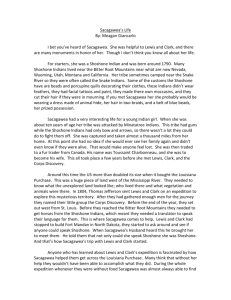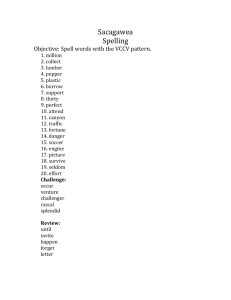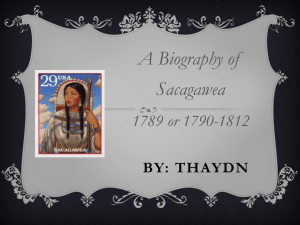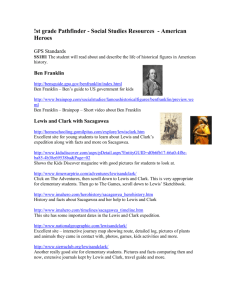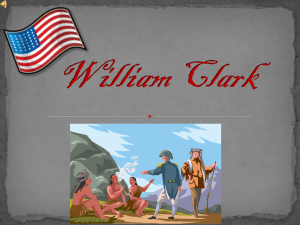Séance 3: the biography of Sacagawea Objectifs: civilisation grace à
advertisement
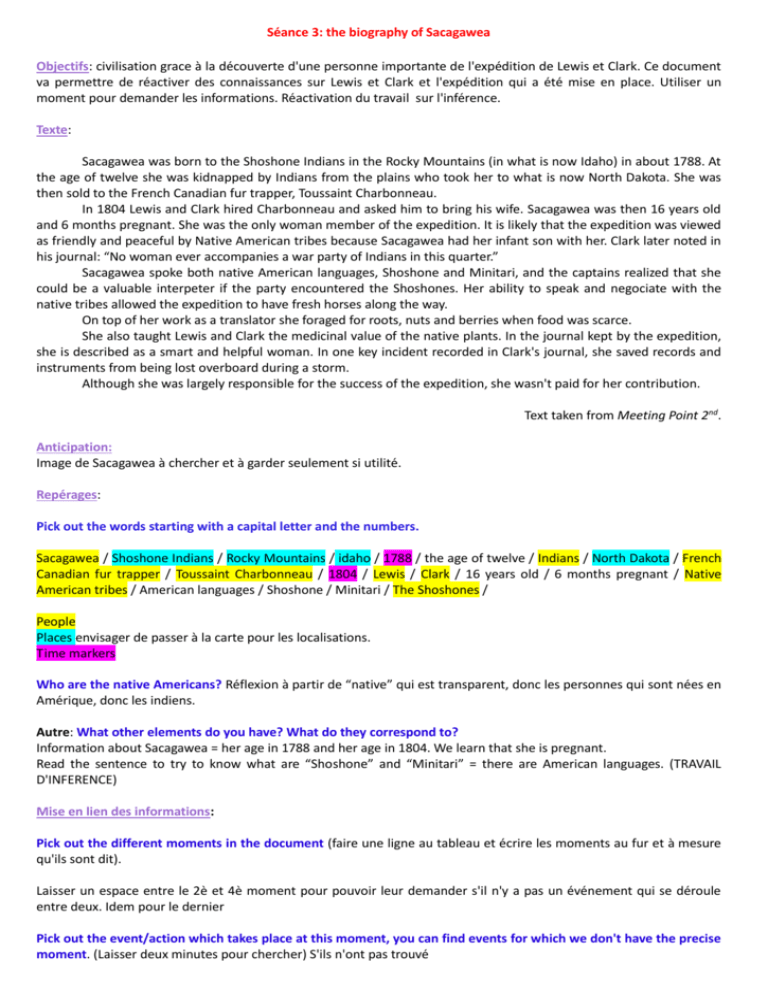
Séance 3: the biography of Sacagawea Objectifs: civilisation grace à la découverte d'une personne importante de l'expédition de Lewis et Clark. Ce document va permettre de réactiver des connaissances sur Lewis et Clark et l'expédition qui a été mise en place. Utiliser un moment pour demander les informations. Réactivation du travail sur l'inférence. Texte: Sacagawea was born to the Shoshone Indians in the Rocky Mountains (in what is now Idaho) in about 1788. At the age of twelve she was kidnapped by Indians from the plains who took her to what is now North Dakota. She was then sold to the French Canadian fur trapper, Toussaint Charbonneau. In 1804 Lewis and Clark hired Charbonneau and asked him to bring his wife. Sacagawea was then 16 years old and 6 months pregnant. She was the only woman member of the expedition. It is likely that the expedition was viewed as friendly and peaceful by Native American tribes because Sacagawea had her infant son with her. Clark later noted in his journal: “No woman ever accompanies a war party of Indians in this quarter.” Sacagawea spoke both native American languages, Shoshone and Minitari, and the captains realized that she could be a valuable interpeter if the party encountered the Shoshones. Her ability to speak and negociate with the native tribes allowed the expedition to have fresh horses along the way. On top of her work as a translator she foraged for roots, nuts and berries when food was scarce. She also taught Lewis and Clark the medicinal value of the native plants. In the journal kept by the expedition, she is described as a smart and helpful woman. In one key incident recorded in Clark's journal, she saved records and instruments from being lost overboard during a storm. Although she was largely responsible for the success of the expedition, she wasn't paid for her contribution. Text taken from Meeting Point 2nd. Anticipation: Image de Sacagawea à chercher et à garder seulement si utilité. Repérages: Pick out the words starting with a capital letter and the numbers. Sacagawea / Shoshone Indians / Rocky Mountains / idaho / 1788 / the age of twelve / Indians / North Dakota / French Canadian fur trapper / Toussaint Charbonneau / 1804 / Lewis / Clark / 16 years old / 6 months pregnant / Native American tribes / American languages / Shoshone / Minitari / The Shoshones / People Places envisager de passer à la carte pour les localisations. Time markers Who are the native Americans? Réflexion à partir de “native” qui est transparent, donc les personnes qui sont nées en Amérique, donc les indiens. Autre: What other elements do you have? What do they correspond to? Information about Sacagawea = her age in 1788 and her age in 1804. We learn that she is pregnant. Read the sentence to try to know what are “Shoshone” and “Minitari” = there are American languages. (TRAVAIL D'INFERENCE) Mise en lien des informations: Pick out the different moments in the document (faire une ligne au tableau et écrire les moments au fur et à mesure qu'ils sont dit). Laisser un espace entre le 2è et 4è moment pour pouvoir leur demander s'il n'y a pas un événement qui se déroule entre deux. Idem pour le dernier Pick out the event/action which takes place at this moment, you can find events for which we don't have the precise moment. (Laisser deux minutes pour chercher) S'ils n'ont pas trouvé 1788 Sacagawea was born to the Shoshone Indians in the Rocky Mountains (what can you conclude about her origins ? She is an Indian) At the age of 12 (1800) She was kidnapped by Indians She was sold to a French Canadian 1804 She takes part in the expedition led by Lewis and Clark Three months later She has a little boy (NB: J'ai fait sous forme de tableau car je ne sais pas faire de frise avec open office) What can you conclude about the nature of the document? This is a biography, Sacagawea's biography. Repérages des idées: In the second paragraph, pick out the words which qualify the expedition = Friendly, peaceful What words do you recognize? Friend and Peace. So, is it a positive or a negative experience? Positive, there was no problem during the journey. Pick out the reason of such a success = “because Sacagawea has her infant with her.” Pousser plus loin la réflexion/hypothèses: why does the fact that she had her infant with her was considered as peaceful and friendly? Because when there is a baby it means that they don't necessarily want to fight, it looks like a family trip. Pick out the verbs of action connected to Sacagawea. “Sacagawea spoke both native American languages”, “speak and negotiate with the native tribes”, “she foraged for roots, nuts and berries when food was scarce”, “she also taught Lewis and Clark the medicinal value of the native plants”. Pick out the words or expressions which qualify Sacagawea. “smart”, “helpful”, “responsible for the success of the expedition”. What can you conclude about her role in the expedition? She had an important place as she was very helpful, specially for the relation with native Americans thanks to her skills. She was also helpful thanks to her knowledge of nature. Pick out the element which shows that the presence of Sacagawea was exceptional. What Clark noted in his journal “No woman ever accompanies a war party of Indians in this quarter.” Why was it exceptional? Because she was a woman. Focus on the last sentence, what the negative aspect underlined? The fact that she wasn't paid, certainly contrary to the other members of the expedition. Trace écrite: This document is a biography, more precisely Sacagawea's biography. Sacagawea was a woman who was born in 1788 in Shoshone Indians, so we can conclude that she is an Indian. When she was twelve years old she was kidnapped by Indians who brought her to what is now North Dakota. A few year later she was sold to a French Canadian. Then, in 1804 she took part in the Lewis and Clark expedition, she was sixteen years old and six months pregnant. There didn't seem to have problems during the expedition as the words to qualify it are “friendly” and “peaceful”. This was thanks to the presence of Sacagawea's newly born son which could give a family aspect to the journey. During the expedition she was very useful thanks to her abilities to speak native American languages (Shoshone and Minitari), and to negociate with the native Americans. She was also helpful to Lewis and Clark thanks to her knowledge of nature (the medicinal value of native plants). As a consequence, we can say that Sacagawea was a very important person in the Lewis and Clark expedition, also because she was the only woman there. However, in spite of what she did, she was not paid.
